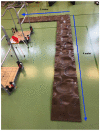Functional, Spiroergometric, and Subjective Comparisons Between Forearm Crutches and Hands-Free Single Crutches in a Crossover Study
- PMID: 37223637
- PMCID: PMC10201150
- DOI: 10.1177/24730114231172734
Functional, Spiroergometric, and Subjective Comparisons Between Forearm Crutches and Hands-Free Single Crutches in a Crossover Study
Abstract
Background: Following below-knee surgery, the optimal medical mobility device remains controversial as adequate nonweightbearing of the operated extremity is critical to ensure successful healing. The use of forearm crutches (FACs) is well established but requires using both upper extremities. The hands-free single orthosis (HFSO) is an alternative that spares the upper extremities. This pilot study compared functional, spiroergometric, and subjective parameters between HFSO and FAC.
Methods: Ten healthy (5 females, 5 males) participants were asked to use HFSOs and FACs in a randomized order. Five functional tests were performed: climbing stairs (CS), an L-shaped indoor course (IC), an outdoor course (OC), a 10-meter walk test (10MWT), and a 6-minute walk test (6MWT). Tripping events were counted while performing IC, OC, and 6MWT. Spiroergometric measurements consisted of a 2-step treadmill test with speeds of 1.5 and 2 km/h, each for 3 minutes. Lastly, a VAS questionnaire was completed to collect data regarding comfort, safety, pain, and recommendations.
Results: Significant differences between both aids were observed in CS and IC (HFSO: 29.3 seconds; FAC: 26.1 seconds, P < .03; and HFSO: 33.2 seconds, FAC: 18 seconds, P < .001, respectively). The other functional tests showed no significant differences. The trip events were not significantly different between the use of the 2 aids. Spiroergometric tests showed significant differences regarding heart rate (HFSO: 131.1 bpm at 1.5 km/h and 131 bpm at 2 km/h; FAC: 148.1 bpm at 1.5 km/h and 161.8 bpm at 2 km/h) and oxygen consumption (HFSO: 15.4 mL/min/kg at 1.5 km/h and 16 mL/min/kg at 2 km/h; FAC: 18.3 mL/min/kg at 1.5 km/h and 21.9 mL/min/kg at 2 km/h) at both speeds (all P < .01). In addition, significantly different ratings regarding the items comfort, pain, and recommendation were recorded. Both aids were equally rated for safety.
Conclusion: HFSOs may be an alternative to FACs, especially in activities that require physical stamina. Further prospective studies in patients with below-knee surgical intervention concerning everyday clinical use would be interesting.
Level of evidence: Level IV pilot-study.
Keywords: crutches; hands-free crutch; postoperative care; postoperative nonweightbearing.
© The Author(s) 2023.
Conflict of interest statement
The author(s) declared no potential conflicts of interest with respect to the research, authorship, and/or publication of this article. ICMJE forms for all authors are available online.
Figures




Similar articles
-
Patient Preference and Physical Demand for Hands-Free Single Crutch vs Standard Axillary Crutches in Foot and Ankle Patients.Foot Ankle Int. 2019 Oct;40(10):1203-1208. doi: 10.1177/1071100719862743. Epub 2019 Aug 2. Foot Ankle Int. 2019. PMID: 31375043
-
Energy cost of ambulation with crutches.Arch Phys Med Rehabil. 1981 Jun;62(6):250-6. Arch Phys Med Rehabil. 1981. PMID: 7235917
-
Comparison of Lower Extremity EMG Muscle Testing With Hands-Free Single Crutch vs Standard Axillary Crutches.Foot Ankle Orthop. 2020 Sep 2;5(3):2473011420939875. doi: 10.1177/2473011420939875. eCollection 2020 Jul. Foot Ankle Orthop. 2020. PMID: 35097398 Free PMC article.
-
Injuries Associated with Crutch Use: A Narrative Review.PM R. 2021 Oct;13(10):1176-1192. doi: 10.1002/pmrj.12514. Epub 2020 Dec 8. PM R. 2021. PMID: 33094912 Review.
-
Walking assistance using crutches: A state of the art review.J Biomech. 2020 Jan 2;98:109489. doi: 10.1016/j.jbiomech.2019.109489. Epub 2019 Nov 14. J Biomech. 2020. PMID: 31831139 Review.
Cited by
-
Prehabilitation for Patients Undergoing Elective Foot and Ankle Surgery: A Contemporary Review.Foot Ankle Orthop. 2024 May 28;9(2):24730114241255136. doi: 10.1177/24730114241255136. eCollection 2024 Apr. Foot Ankle Orthop. 2024. PMID: 38812567 Free PMC article. Review. No abstract available.
-
Walking with unilateral ankle-foot unloading: a comparative biomechanical analysis of three assistive devices.J Neuroeng Rehabil. 2024 Apr 30;21(1):67. doi: 10.1186/s12984-024-01333-w. J Neuroeng Rehabil. 2024. PMID: 38689255 Free PMC article.
References
-
- Berli M, Kokegei D, Schäfer M, Teutrine P. 8 Technische Hilfen. In: Greitemann B, Baumgartner R, eds. Technische Orthopädie. 4th ed.Georg Thieme Verlag; 2018:266-270. doi:10.1055/b-0037-146295 - DOI
-
- Dalton A, Maxwell D, Kreder H, Borkhoff C.Prospective clinical evaluation comparing standard axillary crutches with the hands free crutch. Physiother Can. 2002;54(2):110-115.
LinkOut - more resources
Full Text Sources
Research Materials
